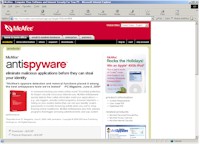How to Choose Anti-Spyware Software
Spyware (or Adware) are malevolent programs that try to steal your private information or try to take control of your computer to display ads. For example, they can record which websites you visit and transmit that information to a centralize computer, or they can attach themselves to Internet Explorer and pop-up ads while you are using the internet. Because they are different from viruses (e.g. they don’t try to replicate, cause damage to your pc, or shut down a website) many virus protection programs and firewalls will let them through.
 |
 |
Shown above, McAfee spyware website (left), Adaware website (right) |
|
Spyware gets installed on a computer in one of several ways. It can be downloaded and installed when you visit a website (not just porn or other fringe sites; seemingly benign sites like a site on world maps). It can also be caught from illegal software and music download sites. Or, it can even be install as part of the normal setup of a legitimate program.
There are four main types of spyware
- Browser Hijackers - replace your chosen home page with one they chose. Often if you try to restore your selection, the spyware will just change it back.
- Search Hijackers - intercept your search requests and return results from their advertisers.
- Pop-up generators - create ad pop-ups that may appear to be generated by the web pages you visit.
- Key Loggers - record every key you press and transmit the information to market to you or to steal your identity.
The best way to avoid spyware is to install a good anti-spyware program and scan your computer regularly.
Attributes
- Detection - Most major software products can detect most of spyware that has been public for a few days. Sometimes it is necessary to run several different programs on the same computer to remove all infections.
- Online Updates - All major software products allow scheduled or manual downloads of the latest definition files.
- Real Time Protection - Many programs have features to catch spyware as it is trying to load and execute.
- Ease of Use - Packages vary in how logically the application are structure.
How To Choose
- Don’t install free spyware programs that are marketed through pop-up ads. Best case, these free programs will less effective than other free programs. Worst case they may even infect your computer with viruses and spyware.
- Consider one of the top-ranked software packages. We infected a computer with 10 different types of spyware, then ran each of the following packages. Their detection results are as follows:
- Install one of the free packages, Adaware, or Spybot Search and Destroy (even if you’ve paid for a spyware program, its not a bad idea to install a free package as well).
- If you are fed up with spyware, perhaps consider buying an Apple computer. Most don’t run on Apples.
| Product (cost) | Detection Performance |
Online Updates |
Realtime Protection |
|
| a. | Adaware (free) | Excellent | Yes | Yes ** |
| b. | McAfee ($40) | Excellent | Yes | Yes |
| c. | Pest Patrol ($40) | Good | Yes | Yes |
| d. | Spybot Search and Destroy (free) | Good | Yes | Yes |
| e. | Spy Sweeper ($30) | Good | Yes | Yes |
Note: the package that charge for the software also have annual fees of $15-$30 for definition updates (the first year is included in the software cost).
** Adaware offers realtime protection only with their paid version.
